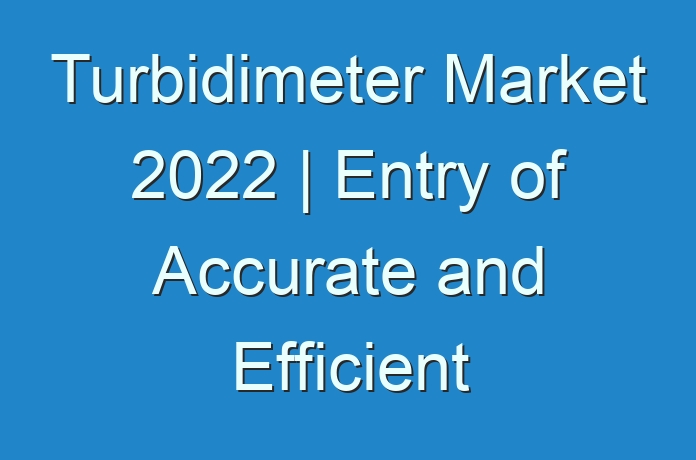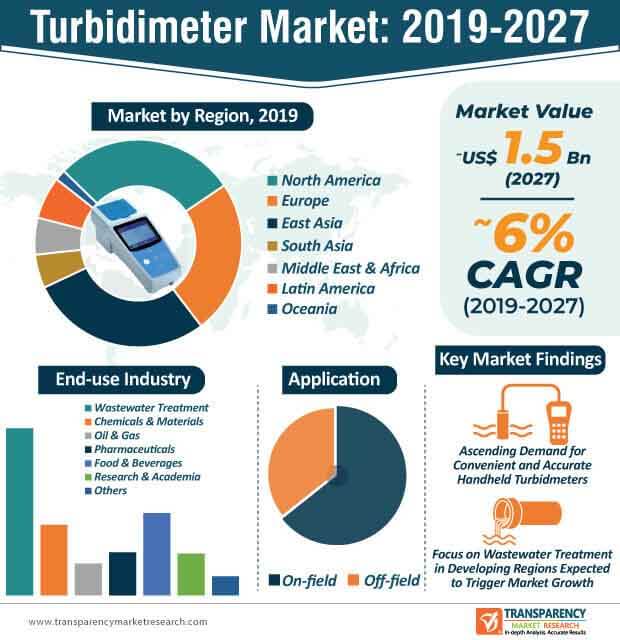
The level of cloudiness or haziness in water has been identified as one of the simplest indicators of water quality. For several decades, turbidity level is used to assess the relative clarity of water. Although other techniques are available to determine the contamination levels in water, turbidity analysis has gained significant acceptance, as it a simple indicator of the overall quality of water. Technological advancements are expected to drive the growth of the turbidimeter market, as novel laser-based procedures are slowly making their entry into the global marketspace. The onset of laser-based procedures has enabled a swift detection of filtration integrity with a high degree of accuracy.
Turbidity measurement is a critical procedure in several industries, including food & beverages, pharmaceuticals, chemicals & materials, and water treatment, among others. While governments across the world, especially of developing countries continue to lay down stringent regulations pertaining to water quality, the demand for turbidimeters is expected to witness substantial growth in the coming years, thus driving the turbidimeter market. Due to the demand from end-use industries coupled with rapid advancements in the turbidity analysis, the turbidimeter market is expected to reach a value of ~US$ 1.5 Bn by 2027 from ~US$ 960 Mn in 2019.

Request a sample to get extensive insights into the Turbidimeter Market
Growing Adoption in Wastewater Treatment Facilities to Drive Turbidimeter Market
In the current scenario, complying with evolving regulatory framework and minimizing operational costs are some of the challenges for wastewater treatment facilities. Within the wastewater treatment space, turbidity is an indicator of effluent quality. Over the past two decades, research and development activities in the turbidimeter market are focusing on improving accuracy, efficiency, and overall performance of the turbidity analysis. Turbidimeters are extensively used across laboratories and on-site water treatment plants for turbidity measurements. However, existing automated techniques demand periodic cleaning and human intervention. Efforts are in place to improve the yield and overall accuracy of turbidimeters.
To understand how our report can bring difference to your business strategy, Ask for a brochure
The wastewater treatment end-use industry segment is expected to account for a major share of the turbidimeter market during the forecast period. The segment is likely to gain 36% market share by 2027. With a CAGR growth of ~5%, this segment is also projected to expand at a rapid rate during the forecast period. In the past two years, deployment of image processing techniques to estimate turbidity in wastewater treatment plants effluents has garnered significant momentum – a key factor that is anticipated to fuel the growth of the turbidimeter market. Moreover, innovations in turbidimeters are likely to play a crucial role in addressing the current set of challenges in the water industry.
Technologically Advanced Instruments to Replace Conventional Turbidimeters
Cutting-edge laser-based technologies are gradually being adopted in the turbidimeter market. Laser-based techniques have proven their efficacy in detecting issues related to filtration integrity with greater efficiency and precision in comparison with the other alternatives. Laser-based turbidimeters have emerged as an ideal solution to cater to the growing requirement of low-level turbidity analysis in relatively cleaner samples of water, owing to their improved optical capabilities and design. Instruments, such as laser-based turbidimeters that have a high signal-to-noise ratio provide stable and consistent measurement baseline levels compared to conventional turbidimeters enabling efficient detection of minute changes in turbidity. The entry of laser-based turbidimeters has played an imperative role in improving the process of detecting filtration integrity deficiencies.
Read TMR Research Methodology at: https://www.transparencymarketresearch.com/methodology.html
The demand for these instruments is expected to grow in the near future, owing to their optimum optical qualities. These laser instruments provide added insights compared to conventional alternatives and thus, could potentially replace them in the coming years. Players operating in the global turbidimeter market are inclined toward improving the accuracy and efficiency of their instruments by leveraging new technologies and techniques, including image processing and laser.
Read Our Latest Press Release:
- https://www.prnewswire.com/news-releases/affordability-and-beneficial-properties-to-serve-as-vital-growth-factors-for-construction-tape-market-during-forecast-period-of-2020-2030-tmr-301221294.html
- https://www.prnewswire.com/news-releases/global-higher-education-solutions-market-to-thrive-on-growing-popularity-of-cloud-computing-and-high-consumption-of-digital-content-tmr-301219732.html





